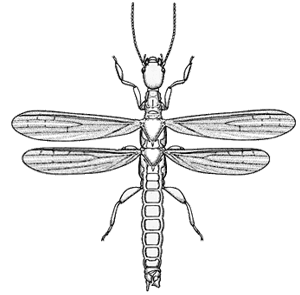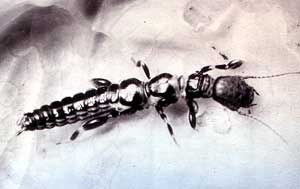|
Embioptera:
web spinners
Characteristics
Web-spinners
are small insects ranging from 4-15 millimetres in body length.
They are rarely seen as they spend most of their lives within the
silken galleries they construct, although male web-spinners may
be attracted to lights at night. Web-spinners are recognised by
the following features:
|

Notoligotoma nitens
|
|
- Elongated,
cylindrical body
- Enlarged
front tarsi
which contains silk glands used to create the galleries they live
in
- 2 pairs of
membranous
wings in some male species. All females are wingless
- 2 short cerci,
which in male web-spinners are unequal in size and shape
Notoligotoma
nitens occurs from Queensland, southwards to Victoria. It is
commonly found inhabiting lichens which grow on ledges, bark flakes
and fence posts. Adults are glossy black in colour.
Life Cycle
Male web-spinners
only live for a short time and those species with wings fly in search
of other mates. After mating female web-spinners either lay their
eggs in an established gallery or disperse to begin a new colony.
The female protects her eggs and on hatching the nymphs
immediately begin to spin silken galleries of their own. The nymphs
resemble the adults and live together with other members of their
family.
Feeding
All stages
of web-spinners feed entirely on plant matter which includes leaves,
bark, mosses and lichens. Web-spinners extend their silken galleries
to obtain new food sources. Adult male web-spinners do not feed.
|

Metoligotoma species
|
Habitat
Web-spinners
are found in many environments throughout Australia despite the
fact they are not well known. They construct their silken nests
in sheltered locations such as under rocks or bark, in soil or plant
litter and in old wood.
Metoligotoma
species prefers to live in leaf litter and occurs mostly in coastal
areas from central Queensland to Tasmania.
|


